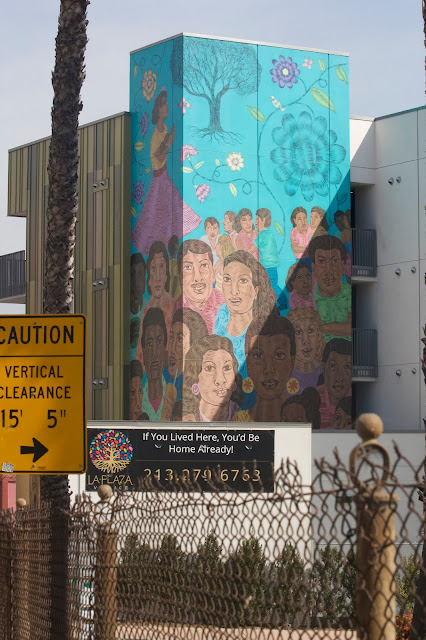 |
| "La Nueva Reina" by Judithe Hernández Studio, La Plaza Village, Los Angeles CA |
And another
 |
| "Aliso Dreams" by José Lozano, La Plaza Village, Los Angeles CA |
Michael Sedano
La Bloga has followed Pola López' hand-painted restoration project of a mural a mile northeast of a pair of spectacular new-technology murals we'll follow now. The murals grace a new residential development near historic Olvera Street, "the birthplace of Los Angeles." Visiting is a short walk from Union Station.
Unveiled in 2019, the mural designs have been printed on massive sheets of vinyl, then clad onto the façades of the structures. For José Lozano and Judithe Hernández, seeing their work in such magnificent scale must be an ongoing pleasure.
Out there in the elements. Rising and setting sun casting shadows inescapably covering and altering the look of the art. Cameras are fooled by the contrast of full sun deep shade, imagine the perplexed tourist insisting there's mural in that white spot. Designed on an easel, now in situ the mural finds competition for attention: traffic and advertising signs, dusty fences, sidewalks lined with tent encampments. And totally beautiful because of all that, que no?
Except...
Technology failed.
She's peeling off at the seams.
She, personification of the city's full name, El Pueblo de Nuestra Señora la Reina de los Ángeles. Guadalupe. She's peeling and everyone can see it.
I'm speculating the installation failure stems from the building joints, not adhesive failure. When two surfaces join, contractors gun in silicone or polyurethane sealants to weatherproof the structure. Sealants guys push backer rod into the joint. Then the crew guns in the sealant and "tools" the synthetic rubber forcefully against the concealed backer rod. The sealant cures fully in 72 hours, during which polymerization exchanges moisture in the air for stuff in the sealant, releasing acetic acid or alcohol vapor to evaporate into the medio ambiente.
I used to sell those materials; I trained the guys who sold that stuff, at any rate. The peeling seams look like "outgassing" problems. Vinyl that covers joints covers the exhaust path of those vapors. There are miles of sealants in those buildings, lots of vapor building up during the cure time.
Who's going to pay for this? That's where outgassing and substrate preparation enter the problem-solving phase. Did the workers do the job wrong? Did the architect specify incompatible materials? What actually got installed in those joints? Was the sealant fully cured, 72 hours is a standard guess, not a sure thing. If the weather has been dry, insufficient moisture is available to initiate curing. Was the sealant properly manufactured? Are batch number documented? Ay de mi, so many questions and fingers pointed.
Not my business, but it used to be. I have horror stories.
Sabes que? I'm gonna start hanging around the scaffolds in the coming weeks while crews strip la reina panel by panel, see if I can score a piece of nueva reina. Where will I display my prize? Nowhere. The historic originals will be properly and environmentally disposed of per the L.A. City Mural Ordinance.








No comments:
Post a Comment